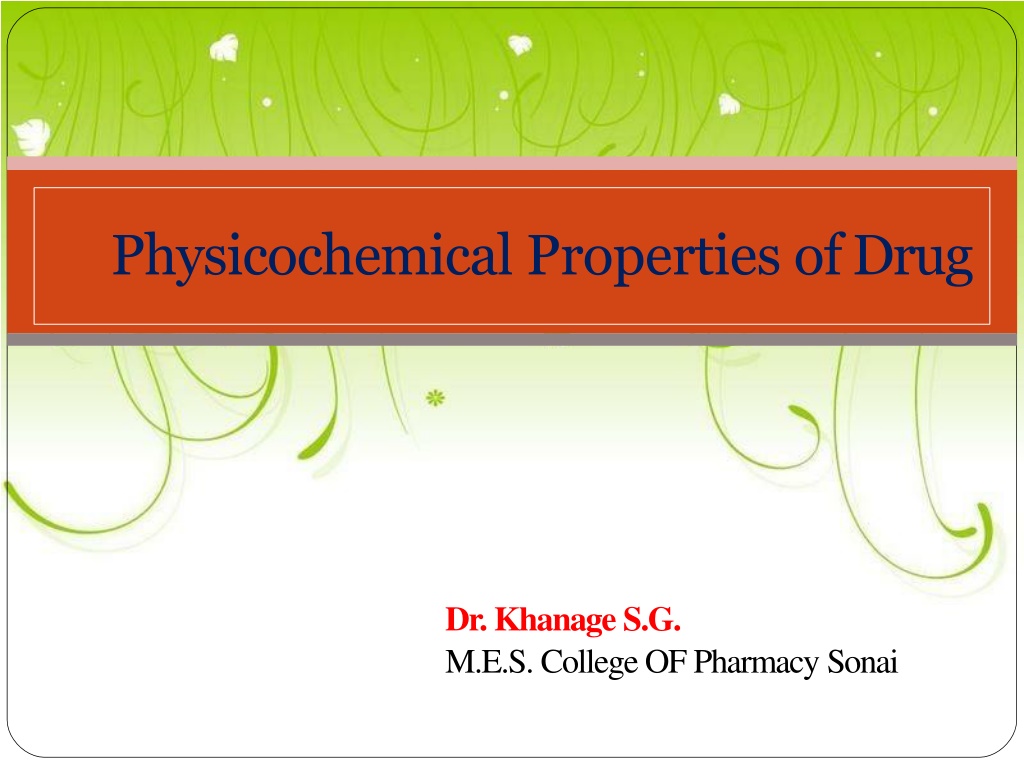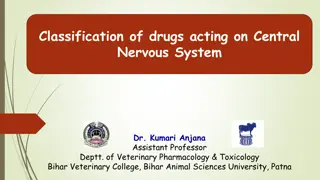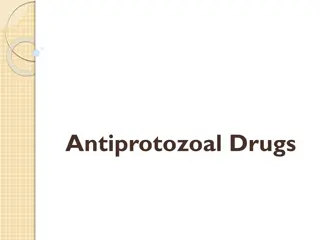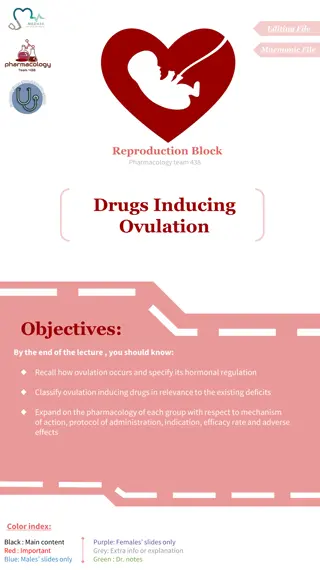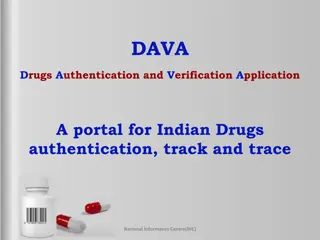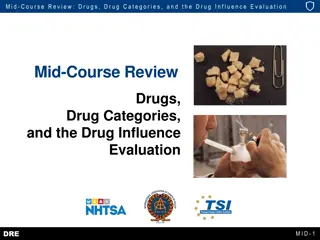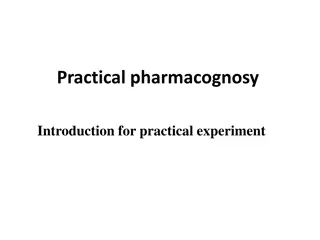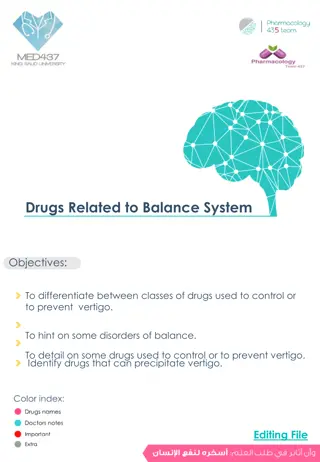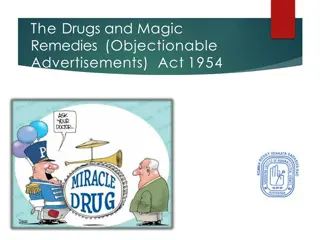Understanding Physicochemical Properties of Drugs
The physicochemical properties of drugs play a crucial role in their pharmacological effects. These properties include physical and chemical characteristics that influence interactions with biomolecules. Solubility, partition coefficient, and dissociation constant are key factors affecting drug behavior. Methods to enhance drug solubility and the importance of solubility in drug formulation and bioavailability are discussed. Partition coefficient impacts drug transport and distribution, determining how drugs reach their target sites. Understanding these properties is essential for drug development and effectiveness.
Download Presentation

Please find below an Image/Link to download the presentation.
The content on the website is provided AS IS for your information and personal use only. It may not be sold, licensed, or shared on other websites without obtaining consent from the author. Download presentation by click this link. If you encounter any issues during the download, it is possible that the publisher has removed the file from their server.
E N D
Presentation Transcript
Physicochemical Properties of Drug Dr. Khanage S.G. M.E.S. College OF Pharmacy Sonai
DEFINITION: The ability of a chemical compound to elicit a pharmacological/ therapeutic effect is related to the influence of various physical and chemical (physicochemical) properties of the chemical substance on the biomolecule that it interactswith. 1)PhysicalProperties Physical property of drug is responsible for its action 2)ChemicalProperties The drug react extracellularly according to simple chemical reactions like neutralization, chelation, oxidation etc.
Various Physico-Chemical Properties are, Solubility PartitionCoefficient Dissociationconstant HydrogenBonding Ionization ofDrug RedoxPotential Complexation Surfaceactivity Proteinbinding Isosterism
1.Solubility: The solubility ofasubstance at agiven temperature isdefined asthe concentration of the dissolved solute, which is in equillibrium with thesolidsolute. Solubility depends on the nature of solute and solvent as well as temperature, pH&pressure. The solubility of drug may be expressed in terms of its affinity/philicity or repulsion/phobicity for either an aqueous or organicsolvent. The atoms and molecules of all organic substances are held together byvarioustypes ofbonds(e.g. hydrogenbond, dipole dipole, ionic bondetc.) These forces are involved in solubility because it is the solvent- solvent, solute-solute, solvent-solute interactions that governs solubility.
Methods to improve solubility of drugs 1)Structural modification (alter the structure of molecules) 2)Use of Cosolvents (Ethanol, sorbitol,PPG,PEG) 3)Employingsurfactants 4)Complexation Importance ofsolubility 1. Solubility concept is important to pharmacist because it govern the preparation of liquid dosage form and the drug must be in solution before it is absorbed by the body to produce the biologicalactivity. 2. Drugmustbeinsolutionformto interactwith receptors.
2. PartitionCo-efficient PC Drug( a q u e o u s ) Drug(lipid) Partition co-efficient is one of the Physicochemical parameter which influencing the drug transport & drug distribution., the way in which the drug reaches the site of action from the site of application. Partition co-efficient is defined as equilibrium constant of drug concentrationforunionizedmoleculeintwo phases. P[Unionizedm o l e c u l e ] = [drug]lipid [drug]water
For ionized (acids, bases and salts) P[Ioniz e dm o l e c u l e ] = [drug]lipid [1-a][drug]water a= degreeofionizationinaqueoussolution. Partition coefficientaffectsthedrugtransfer characteristics. The contribution of each functional group & structural arrangement help to determine the lipophilic or hydrophilic characterofdrug molecules. It iswidelyusedin QSAR.
Factors affecting Partition Co-efficient pH Cosolvents Surfactant Complexation Partition Co-efficient are difficult to measure in living system. They are usually determined in vitro 1-octanol as a lipid phase and phosphate buffer of pH 7.4 as the aqueous phase. 1-octanol as a lipid phase because, It has polar and nonpolar region Po/w is easy to measure Po/w often correlates with many biologicalproperties It can be predicted using computational mode
The Partition co-efficient, P is dimensionless and its logarithm, log P is widely used as the measure oflipophilicity. The log P is measured by the followingmethods. 1) Shake flask method 2) Chromatographic method (HPLC) Phenobarbitone has a high lipid/water partition coefficient of 5.9. Thiopentone sodium has a chloroform/water partition coefficient of about 100, so it is highly soluble in lipid. Hence, thiopentone sodium is used as ultra-short actingbarbiturates.
What else does lopP affects? Binding to enzymes /receptor Aqueous solubility logP Binding to P450 metabolising enzymes Absorbance through membrane Binging to blood/tissue proteins
Importance of partician coefficient It is generally used in combination with the Pka the distribution of drug in biological system. The factor such as absorption, excretion & penetration of the CNS may be related to the log P value of drug. The drug should be designed with the lowest possible Log P , to reduce toxicity , & bioavailability. to predict nonspecific binding
3. HydrogenBond The hydrogen bond is a special dipole-dipole interaction between the hydrogen atom in a polar bond such as N-H, O-H or F-H & electronegativeatomO, N,Fatom. Dipoles result from unequal sharing ofelectrons between atoms within acovalent bond. Theseare weakbondsanddenoted asdotted lines. O-H .O,HN-H .O, The compounds that are capable, of forming hydrogen bonding is only soluble inwater. hydrogen bonding is classified into 2 types: 1. Intermolecular 2. Intramolecular
1) Intermolecular hydrogenbonding It is occur between two or more than two molecules of the same or different compound. Due to this increase the boiling point of the compound & increase the molecular weight of compound hence more energy is required to dissociate the molecular for vaporization.
2) Intramolecular Hydrogenbonding H-bonding occurs within two atoms of the samemolecules. This type of bonding is known as chelation and frequently occurs in organiccompounds. Sometimes h-bond develop six or five member rings Due to decrease the boilingpoint O H O H O O C N OH O salicylicacid o-nitrophenol
Hydrogen Bonding and biological action Eg. 1) Antipyrin i.e. 1- phenyl 2,3- dimethyl 5- pyrazolone has analgesic activity. C6H5 N CH3 N O H3C 1-phenyl-3-methyl-5-pyrazolone is inactive. C6H5 H N HN O HN O H3C H3C
Salicylic acid (O-Hydroxy Benzoic acid) has antebacterial activity O H O C OH Para and meta Hydroxy Benzoic acids are inactive. O O OH C HO C OH OH
Effect ofH-bonding All physical properties affected by H-bonding, 1. Boiling and Melting point 2. Watersolubility 3. Strength ofacids 4. Spectroscopicproperties 5. On surface tension and viscosity 6. Biologicalproducts 7. Drug-receptorinteraction
4. Chelation/Complexation Complex of drug molecules can t cross the natural membrane barriers, they render the drug biologicalineffectivity. The rate of absorption is proportional to the concentration of the free drug molecules i.e. the diffusion ofdrug. Due to reversibility of the Complexation, equillibrium between free drug and drug complex Drug + complexingagent Drugcomplex Complexation reduce the rate of absorption of drug but not affect the availability of drug
Importance of chelates in medicine: a)Antidote for metal poisoning 1.Dimercaprol is a chelating agent. CH2SH CH2S As As++ + CHS CHSH CH2OH CH2OH 2.Penicillamine CH3 CH3 CH3 CU++ H C H C H C CH3 CH3 CH3 C COOH C COOH C COOH SH NH2 S NH2 S NH2 CU UC 1:1 chelate NH2 S 1:2 chelate CH3 HOOC CH3
8-Hydroxyquinoline and its analogs acts as antibacterial and anti fungal agent by complexing with iron or copper. Undesirable side effects caused by drugs, which chelates with metals. A side effect of Hydralazine a antihypertensive agent is formation of anemia and this is due to chelation of the drug with iron. Phenobarbital forms a non-absorbable complex with polyethyleneglycol-4000. Calcium with EDTA form complex which is increase the permeability ofmembrane.
5.Ionization of drug Most of the drugs are either weak acids or base and can exist in either ionised or unionisedstate. = Protonation or deprotonation resulting in charged Ionization molecules. The ionization of the drug depends on its pKa & pH. Therate ofdrugabsorptionisdirectlyproportional to the concentration ofthe drug at absorbableform but not the concentration ofthe drug at theabsorption site. Ionization form imparts good water solubility to the drug which is requiredofbindingofdrugandreceptor interaction Unionizedformhelpsthedrugto crossthecell membrane. Eg;Barbituricacidisinactivebecauseit isstrong acid. while, 5,5 disubstituted Barbituric acid has CNS depressant action becauseit isweak acid.
H3O+ H2O A- C o n u g a t e b a s e H A U n i o n i z e d A c i d C o n j u g a t e a c i d B H+ H2O H3O+ B C o n u g a t e a c i d i o n i s e d C o n u g a t e b a s e According to Henderson-Hasselbalchequation pH-pKa = log[ionized/unionised] pH-pKa = log[unionized/ionised] forbase %ionisation = 100\[ 1+10 ( p H - p k a )] foracids When an acid or base is 50% ionised: pH = pKa Eg: the solution of weak acid Aspirin in stomach (pH-1.0) will get readily absorbed because it is in the un-ionosed form(99%).
Eg:Phenytoin injection must be adjusted to pH 12 with Sodium Hydroxide to obtain 99.98% of the drug in ionised form. Tropicamide eye drops an anti cholinergic drug has a pkaof 5.2 and the drug has to be buffered to pH 4 to obtain more than 90% ionisation. Importance of Ionization of drug Weak acid at acid pH: more lipid soluble because it is uncharged, the uncharged form more readily passes through the biological membranes. RCOO-+ H+= RCOOH Weak base at alkaline pH: more lipid soluble because it is uncharged, the uncharged form more readily passes through the biologicalmembranes. RNH+= RNH2 + H+
6. RedoxPotential The oxidation-reduction potential may be defined as a quantitative expression of the tendency that a compound has to give or receiveelectrons. The correlation between redox potential and biological activity can only be drawn for the compound of very similar structure andproperties. The redox potential of a system may be calculated from the followingequation. E=E0+0.0592/n log[conc. of reductant /conc. of oxidant]
Examples, 1) Riboflavinanalogues The biological activity of riboflavin is due to E=-0.185 volt. OH O H OH O H OH O H O H OH C l N N O N N O NH C l N NH O Dichloro riboflavin N O riboflavin Riboflavin analogue E0 = -0.095V Riboflavin E = -0.185 V 0 2).The optimum bacteriostatic activity in quinones isassociated with the redox potential at +0.03 volt, when tested against Staphylococcusaureus.
7. SurfaceActivity Surfactant is defined as a material that can reduce the surface tension of water at very low concentration. Surface active agents affect the drug absorption which depends on: 1.The chemical nature of surfactant 2.Itsconcentration 3.Its affect on biological membrane and the micelle formation. Inlowerconc. ofsurfactantenhancedthe rate ofabsorption because amphiphilies reduces the surface tension and better absorption. Inhigherconc.ofsurfactantreducedtherateof absorption.
Applications: 1.The antihelmentic activity of hexylresorcinol 2.Bactericidal activity of cationic quaternary ammonium compounds. 3.Bactericidal activity of aliphatic alcohols. 4.Disinfectant action of phenol and cresol. 5.Bile salt solutions of approximately physiological concentration greatly enhance the dissolution rate ofpoorly water soluble drugs like grasiofulvin, hexestrol by micellar solubilization effect.
8. Proteinbinding The reversible binding of protein with non-specific and non- functionalsite on the body protein without showing any biologicaleffectis called as protein binding. Protein + drug Protein-drugcomplex Dependingonthe whether the drug is a weak or strong acid,base or is neutral, it can bind to single blood proteins to multiple proteins (sereum albumin, acid-gycoprotien or lipoproteins).The most significant protein involved in the binding of drug is albumin, which comprises more than half of bloodproteins.
protein binding values are normally given as the percentage of total plasma concentration of drug that is bound to all plasma protein. Drug /protein complex(Dp) Freedrug(Df) + Freeprotein(Pf) (Dt)= (Df) +(Dp Total plasmaconcentration
9. Stereochemistry ofdrugs Stereochemistry involve the study of three dimensional nature of molecules. It is study of the chiral molecules. Stereochemistry plays a major role in the pharmacological propertiesbecause; 1. Any change in stereo specificity of the drug will affect its pharmacologicalactivity 2. The isomeric pairs have different physical properties (log p, pKa etc.) and thus differ in pharmacological activity. The isomer which have same bond connectivity but different arrangement of groups or atoms in the space are termed stereoisomer.
Conformational Isomers Different arrangement of atoms that can be converted into one another by rotation about single bonds are calledconformations. Rotation about bonds allows inter conversion of conformers.
Aclassicalexampleisofacetylcholinewhichcanexistindifferent conformations. N HN+ N OCOCH3 N+ H3COCO H H H H H H H H H H H H H H H OCOCH3 OCOCH3 Staggered Eclipsed Fully Eclipsed GAUCHE N+ O I- O 2-Acetoxycyclo propyl trimethyl ammonium iodide
OpticalIsomers Stereochemistry, enantiomers,symmetryandchiralityare conceptintherapeutic and toxic effect of drug. impotant A chiral compound containing one asymmetric centre has two enantiomers. Although each enantiomer has identical chemical & physical properties, they may have different physiological activity like interaction with receptor, metabolism & proteinbinding. Aoptical isomers in biological action is due to one isomer being able to achieveathree point attachment with its receptor molecule while its enantiomer would onlybe ableto achieveatwo point attachment withthesamemolecule.
(-)-Adrenaline (+)-Adrenaline
E.g.Ephedrine & Psuedoephedrine CH3 CH3 H NHCH3 H NHCH3 HO H H OH MP = 118-120 MP = 37-39 1 gram/200 mL 1 gram/20 mL Ephedrine (Erythro) Pseudoephedrine (Threo)
The category of drugs where the two isomers have qualitatively similar pharmacological activity but have different quantitative potencies. O O O H OH O O O O (s)-(-)warfarin (R)-(+)warfarin
GeometricIsomerism Geometric isomerism is represented by cis/trans isomerism resulting from restricted rotation due to carbon-carbon double bond or in rigid ring system. OH HO OH HO cis-diethylstibesterol Only 7% activity of the trans isomer trans-diethylstibesterol Estrogenic activity
Longmuir introduced the term isosterism in 1919, which postulated that two molecules or molecular fragments containing an identical number and arrangament of electron should have similar properties and termed as isosteres. Isosteres should be isoelectric i.e. they should possess same total charge.
Bioisosterism is defined as compounds or groups that possess near or equal molecular shapes and volumes, approximately the same distribution of electron and which exhibit similar physical properties. They are classified into two types., i)Classicalbiososteres ii)Non classicalbioisosters.
ClassicalBioisosteres They have similarities of shape and electronic configuration of atoms, groups and molecules which they replace. The classical bioisosteres may be, Univalent atoms and groups i)Cl, Br, I ii) CH3, NH2, -OH,-SH Bivalent atoms and groups i)R-O-R,R-NH-R, R-S-R,RCH2R ii) CONHR, -COOR,-COSR
Trivalent atoms andgroups i)-CH=, -N= ii) p=, -AS= Tetravalent atoms and groups =c=, =N=, =P= Ringequivalent -CH=CH-,-S-,-O-,-NH,-CH2-
Application of Classical Bioisosteres in in drug design i) Replacement of NH 2 group by CH3 group. R SO2 NH CONH(CH2)3CH3 Carbutamide Tolbutamide R= NH2 R=CH3 ii)Replacement of OH &-SH X HN NH Guanine=-OH 6-Thioguanine = -SH H2N N N
Non classicalBioisosteres They do not obey the stearic and electronic definition of classical isosteres. Non-classical biosteres are functional groups with dissimilar valence electronconfiguration. Specificcharacteristics: Electronicproperties Physicochemical property ofmolecule Spaticalarrangement Functional moiety for biological activity
Examples Halogens Ether Carbonylgroup Cl, F, Br,CN -S-,-O- O O O S Hydroxyl group OH, -NHSO2R,CH2OH Catechol HO HO Catechol
A classical e.g. of ring Vs. noncycclic structure is Diethylstilbosterol & 17- oestradiol. O H OH H H H H O 17- oestradiol. HO trans-diethylstibesterol
